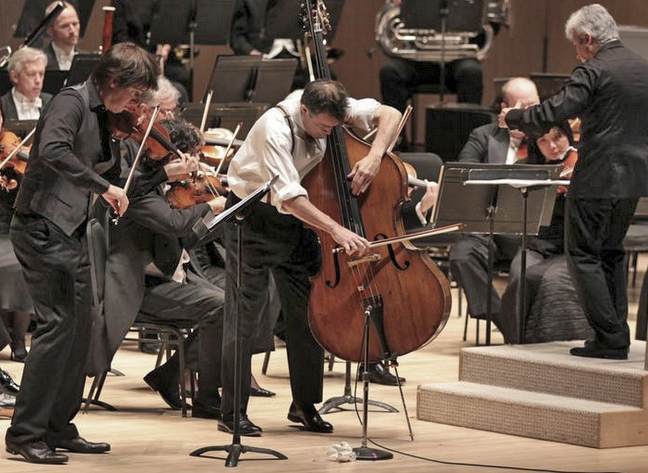June 5, 2013. Roy Thomson Hall, Toronto. Photo: Josh Clavir
It was a starry, starry night. Double-bass virtuoso Edgar Meyer co-starred with Joshua Bell in the Canadian premiere of Meyers’ Double Concerto for violin and bass. Peter Oundjian proved stellar in perfectly pacing a program of four spectacular compositions so they each glittered and glowed. The TSO showed itself again as an all-star ensemble whose soloists can arise like guiding lights as principal clarinet Joaquin Valdepeñas did.
The evening opened with Copland’s Appalachian Spring, a gorgeously orchestrated fanatasia based on the melody of a Puritan theme—“Tis the gift to be simple, ‘tis the gift to be free.” It winds like breeze or mountain brook through a soundscape animated successively by the song of orchestral creatures, violin, flute, horn, oboe, trumpet, bassoon, the melliflous clarinet, and fanfares of brass. The middle section is reflective in the way of Mahler’s Songs of a Wayfarer, or the anthem “Let Erin Remember”. The concluding mood moves from thoughtfulness to celebration in toe-tapping syncopated dance rhythms of polka and hoedown, concluding warmly with a choir of winds, strings and brass that trails off into a distance of bells.
Meyer’s Double Concerto lives on the outskirts of the same tonic zone as the Copland. It is a hybrid, built on Baroque and Classical models, modified by the tonal neo-romantic modernism of Samuel Barber. You can also hear minimalist murmurings, some jazz, bluegrass in the fiddling, and rhythmic traces of Hindustani music throughout its very engaging 28 minutes. At moments in the first movement, I was inspired to think of Shostakovich, but without the paranoia.
The energy of the work develops through the dialogue of violin and double-bass, a pairing as unlikely as Schwartznegger and Danny DeVito. Their intricate, harmonically unstable twinings, invite intriguing comment from flute, clarinet, other winds and harp calling to each other across a terraced orchestral landscape. Joshua Bell, Meyer’s longtime buddy and dedicatee of the work, really smokes during the several dual cadenza’s as he runs rings around Meyer’s meandering bass moans, groans and deep vibrations. The musical moves are interesting at every point, though not always very profound. I enjoyed the bass played pizzicato punctuated by the harp towards the close of the middle movement. The ‘fiddle’ part of the finale, against the prominent brass and furtive low strings and winds, is wickedly difficult, but Bell just danced it to the end of its time where the energy subsided and expired like a light going out. The audience responded with well-earned ovations. It was intermission and I was contented, but the two rich offerings that followed each aroused appetite for more.
“Spellbinding” is the word for Joshua Bell’s performance of the treacherous cadenza that opens Ravel’s Tzigane, with its extremes of register, double-stops, harmonics, portamento and pizzicato all either at blazing speeds or in irregular spurts with unpredicatably long rests. Ravel’s music is totally Gypsy but totally Ravel, never straying into the delectable, even irresistable cliche’s of Bizet or Sarasate’s Zigeunerweisen. When the orchestra comes with with strings and clarinet, they get a Klezmer vibe going, but the music never strays far from the taste of Ravel’s marvelously subtle ear.
The evening ended with a chestnut that turned out to be the most profound music we heard. Respighi’s Pines of Rome, as Maestro Oundjian conducted it with his excellent orchestra was music that brought thoughts “ too deep for tears.” The recorded voice of a nightingale playing over speakers in concert with piano, clarinet and harp restored the charm that befits a fine musical evening.

